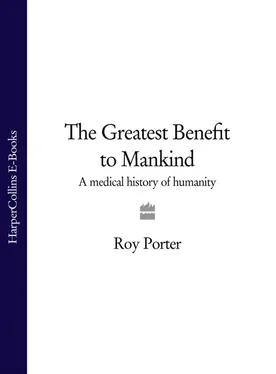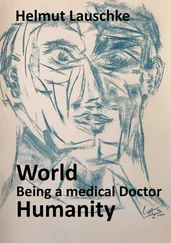Settlement also brought malaria. ‘There is no doubt’, judged the distinguished Australian immunologist, Macfarlane Burnet (1899–1985), ‘that malaria has caused the greatest harm to the greatest number’ – not through cataclysms, as with bubonic plague, but through its continual winnowing effect. First in sub-Saharan Africa and elsewhere since, conversion of forests into farmland has created environments tailormade for mosquitoes: warm waterholes, furrows and puddles ideal for rapid breeding. Malaria is worth pausing over, since it has coexisted with humans for thousands of years and remains out of control across much of the globe.
The symptoms of malarial fevers were familiar to the Greeks, but were not explained until the advent of tropical medicine around 1900. They are produced by the microscopic protozoan parasite Plasmodium, which lives within the body of an Anopheles mosquito, and is transmitted to humans through mosquito bites. The parasites move through the bloodstream to the liver, where they breed during an incubation stage of a couple of weeks. Returning to the blood, they attack red blood cells, which break down, leading to waves of violent chills and high fever.
Malarial parasites have distinct periodicities. Plasmodium vivax, the organism causing benign tertian malaria, once present in the English fenlands, has an incubation period of ten to seventeen days. The fever lasts from two to six hours, returning every third day (hence ‘tertian’); marked by vomiting and diarrhoea, such attacks may recur for two months or longer. In time, as Greek doctors observed, the spleen enlarges, and the patient becomes anaemic and sometimes jaundiced. Quartan malaria, caused by Plasmodium malariae, is another mild variety.
Malignant tertian malaria, caused by Plasmodium falciparum, is the most lethal, producing at least 95 per cent of all malarial deaths. The incubation period is shorter but the fever more prolonged; it may be continuous, remittent or intermittent. Plasmodium falciparum proliferates fast, producing massive destruction of red blood cells and hence dangerous anaemia; the liver and spleen also become enlarged.
Malaria may sometimes appear as quotidian fever, with attacks lasting six to twelve hours – the result of multiple infection. Patients may also develop malarial cachexia, with yellowing of the skin and severe spleen and liver enlargement; autopsy shows both organs darkened with a black pigment derived from the haemoglobin of the destroyed red blood cells. What the ancients called melancholy may have been a malarial condition.
Malaria shadowed agricultural settlements. From Africa, it became established in the Near and Middle East and the Mediterranean littoral. The huge attention Graeco-Roman medicine paid to ‘remittent fevers’ shows how seriously the region was affected, and some historians maintain the disease played its part in the decline and fall of the Roman empire. Within living memory, malaria remained serious in the Roman Campagna and the Pontine marshes along Italy’s west coast.
Coastal Africa was and remains heavily malarial, as are the Congo, the Niger and hundreds of other river basins. Indigenous West African populations developed a genetically controlled characteristic, the ‘sickle-cell’, which conferred immunity against virulent Plasmodium falciparum. But, though protective, this starves its bearers, who are prone to debility and premature death: typical of such evolutionary trade-offs, gains and losses are finely balanced.
India was also ripe for malarial infection. Ayurvedic medical texts (see Chapter Six) confirm the antiquity of the disease in the subcontinent. China, too, became heavily infected, especially the coastal strip from Shanghai to Macao. And from the sixteenth century Europeans shipped it to Mesoamerica: vivax malaria went to the New World in the blood of the Spanish conquistadores, while falciparum malaria arrived with the African slaves whom the Europeans imported to replace the natives they and their pestilences had wiped out.
Malaria was just one health threat among many which set in with civilization as vermin learned to cohabit with humans, insects spread gastroenteric disorders, and contact with rodents led to human rickettsial (lice-, mite- and tick-borne) arbo diseases like typhus. Despite such infections encouraged by dense settlement and its waste and dirt, man’s restless inventive energies ensured that communities, no matter how unhealthy, bred rising populations; and more humans spawned more diseases in upward spirals, temporarily and locally checked but never terminated. Around 10,000 BC, before agriculture, the globe’s human population may have been around 5 million; by 500 BC it had probably leapt to 100 million; by the second century AD that may have doubled; the 1990 figure was some 5,292 million, with projections suggesting 12 billion by 2100.
Growing numbers led to meagre diets, the weak and poor inevitably bearing the brunt. But though humans were often malnourished, parasite-riddled and pestilence-smitten, they were not totally defenceless. Survivors of epidemics acquired some protection, and the mechanisms of evolution meant that these acquired sophisticated immune systems enabling them to coexist in a ceaseless war with their microbial assailants. Immunities passed from mothers across the placenta or through breast-feeding gave infants some defence against germ invasion. Tolerance was likewise developed towards parasitic worms, and certain groups developed genetic shields, as with the sickle-cell trait. Biological adaptation might thus take the edge off lethal afflictions.
Some diseases, however, were not so readily coped with: those caused by the zoonoses (animal diseases transmissible to man) which menaced once civilization developed. By 3000 BC cities like Babylon, with populations of scores of thousands, were rising in Mesopotamia and Egypt, in the Indus Valley and on the Yellow River, and later in Mesoamerica. In the Old World, such settlements often maintained huge cattle herds, from which lethal pathogens, including smallpox, spread to humans, while originally zoonostic conditions – diphtheria, influenza, chickenpox, mumps – and other illnesses also had a devastating impact. Unlike malaria, these needed no carriers; being directly contagious, they spread readily and rapidly.
The era of epidemics began. And though some immunity would develop amongst the afflicted populations, the incessant outreach of civilization meant that merchants, mariners and marauders would inevitably bridge pathogen pools, spilling diseases onto virgin susceptibles. One nation’s familiar ‘tamed’ disease would be another’s plague, as trade, travel and war detonated pathological explosions.
The immediate consequence of the invasion of a town by smallpox or another infection was a fulminating epidemic and subsequent decimation. Population recovery would then get under way, only for survivors’ heirs to be blitzed by the same or a different pestilence, and yet another, in tide upon tide. Settlements big enough to host such contagions might shrink to become too tiny. With almost everybody slain or immune, the pestilences would withdraw, victims of their own success, moving on to storm other virgin populations, like raiders seeking fresh spoils. New diseases thus operated as brutal Malthusian checks, sometimes shaping the destinies of nations.
Cities assumed a decisive epidemiological role, being magnets for pathogens no less than people. Until the nineteenth century, towns were so insanitary that their populations never replaced themselves by reproduction, multiplying only thanks to the influx of rural surpluses who were tragically infection-prone. In this challenge and response process, sturdy urban survivors turned into an immunological elite – a virulently infectious swarm perilous to less seasoned incomers, confirming the notoriety of towns as death-traps.
Читать дальше












